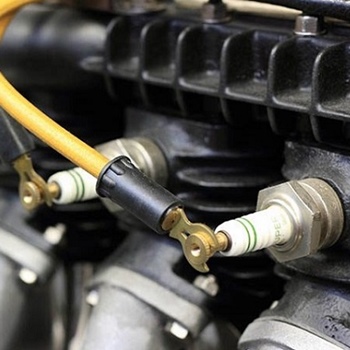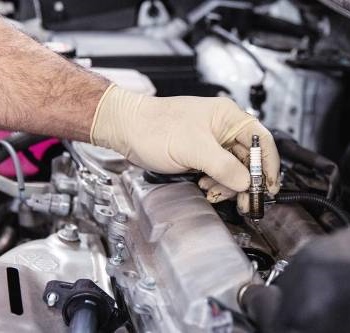I always say – being the master of your own vehicle is a special and unique type of independence everyone should experience. Fixing minor things when your car stops or misbehaves is not only a confidence-booster but a money-saver as well. Car’s are, well, complicated. The more I learn and explore the beautiful world of automobiles, the more I realize that common issues can actually be fixed at home, inside the comfort of my own garage. I’d like everyone to get to that level, or at least try to.
In this article, I’d like to address a very complex topic of replacing and rewiring spark plugs. We will go through some core parts of a standard internal combustion engine, so fasten your seatbelts and get ready to learn a thing or two about the driving force of your car.
Spark Plugs 101
 The phrase “internal combustion” is not there for no reason. Inside the pistons of an engine, the gas mixes with air and, well, combusts. These controlled explosions provide your car with enough force to move the wheels and all the other essential parts under the hood. In simple terms – the functionality of your car heavily relies on these controlled combustions.
The phrase “internal combustion” is not there for no reason. Inside the pistons of an engine, the gas mixes with air and, well, combusts. These controlled explosions provide your car with enough force to move the wheels and all the other essential parts under the hood. In simple terms – the functionality of your car heavily relies on these controlled combustions.
But, in order to fire and stay stable while doing it, every engine needs a predetermined sequence. For example, an engine with 4 clips needs to fire in such a way to minimize damaging itself. Confusing? Let’s make it even simpler.
Every chamber of the engine needs a couple of things to work:
- Gas as fuel to feed the combustion
- Air to mix with the gas to make the ignition easier
- A spark to start the ignition – provided by the spark plug
So, an engine with 4 clips needs 4 spark plugs, an engine with 6 needs 6, and so on. But the spark plugs need a firing sequence or the engine won’t work properly.
The Owner’s Manual Is Your Best Friend
One thing I learned over the years, from my own mistakes and those of others, is that the owner’s manual holds the solution to so many car-related problems. When it comes to spark plugs and the firing sequence, you will most likely have to bust out the old manual. If you cannot find it, the internet will help you. But, why do you need it?
Well, finding the 1st spark plug in the sequence, aka the beginning, is essential for the engine to work. In most cases, the manufacturer will mark the 1st spark plug somehow, but that is not the rule. Sometimes, the mark wears off and being unable to find it will hinder all your efforts to get the sequence right. Unless you find that info in the manual.
The unwritten rule is to put the 1st spark plug/piston upfront and make it face the front side of the vehicle. But this rule is not set in stone, so if you are not sure, guessing just won’t do.
Patience is Key
The most common firing sequence, aka spark plug order, for 4-cylinder engines is the 1-3-2-4 (we’ll get to that in a sec). If you are not sure whether this is correct for your car, you can experiment, but the manual knows best. I can tell you that the sequence will never be 1-2-3-4, no matter how logical and orderly it sounds.
So, the numbers mark the order in which the pistons fire. Since the full cycle requires a 720° rotation to complete, every spark plug/piston/clip account for a ¼ of that or 180°. If the sparks fired in numerical order, or 1-2-3-4, the heat and the force would get disbalanced, and the ignition sequence would physically damage the engine.
Once you determine the 1st spark plug position, either through the manual or the marking on the engine, do not rush the remaining ones.
Trial and Error
 Connect the 1st spark plug through the terminal cables, and turn the hey. The rotator of the engine should align with the next piston that is supposed to fire – most likely the 3rd one. Repeat and see whether the engine starts in the end.
Connect the 1st spark plug through the terminal cables, and turn the hey. The rotator of the engine should align with the next piston that is supposed to fire – most likely the 3rd one. Repeat and see whether the engine starts in the end.
There is an easy way to determine whether or not you managed to match the 1st plug in the sequence. If the 1st plug isn’t in its place, the engine won’t even turn. However, the engine can work with the other plugs not properly sequenced. It will work, yes, but it will sound like an animal in pain. If this happens stop what you’re doing and reset. Too much strain from the wrong firing sequence can cause:
- Engine vibration, causing the whole vehicle to feel clunky and unsafe
- Bearing damages – if pistons fire in numerical order, the force will remain on one side for longer than the material can handle. If the bearings brake, the engine suffers damage that will most likely be irreversible
- Heat damage – we are talking about combustion and controlled explosions repeating hundreds of times. The heat from the air-gas mixture, if not distributed evenly, can start melting the integral parts of the engine.
Wrap Up
I hope I didn’t confuse you with all the talk about this intricate and powerful thing we call the internal combustion engine. Remember, no one expects you to become an expert on the topic. However, discovering how the engine works will help you resolve simple issues faster, better, and safer, ultimately making you a better driver. If you get confused by all of this, or you can’t find the owner manual to help you start, you can always drive to a mechanic’s shop and resolve the problems with professional help.
The reason why I’d like to encourage you to learn about your car is simple – once the engine stops in the middle of the road, or during an emergency, having the knowledge to quickly diagnose and alleviate the problem I something no amount of money can buy. Now go out there and enjoy your rides!